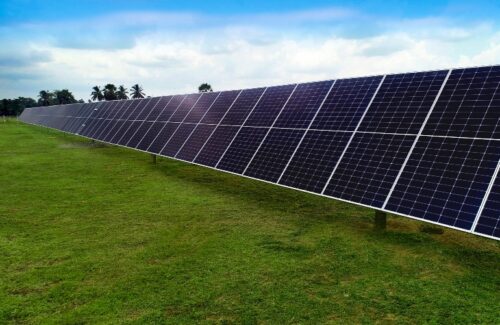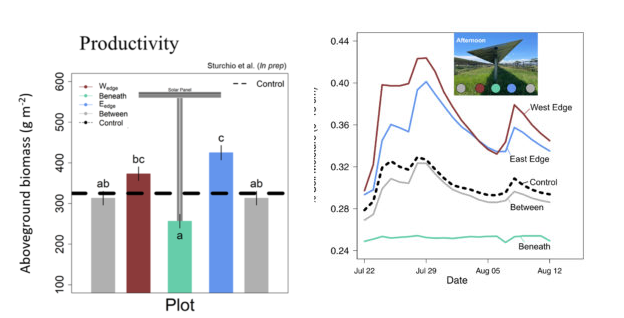According to pv Magazine - FEBRUARY 20, 2023 BEATRIZ SANTOS
US researchers are studying how agrivoltaic systems mounted on Single Pole Ground Mounting trackers affect rainfall and light redistribution at a 1.2 MW installation on grassland in Boulder, Colorado.

Scientists at Colorado State University are investigating how the redistribution of rainfall and light caused by agrivoltaic systems mounted on single-axis trackers can affect the growth of non-irrigated grassland. The study is part of the Sustainably Colocating Agricultural and Photovoltaic Electricity System (SCAPES) project, funded by the US Department of Agriculture.
“What we found is that on the drip edges of modules, depending on whether you’re tilting to the east or the west when there is a rainfall, you can get somewhere between two to five times the amount of precipitation dumped in one spot,” PhD student Matthew Sturchio told pv magazine. “If you want to quantify that for Colorado, it’s about changing the annual precipitation from 350 mm to 1,200 mm of rain. When you do that, you can really improve the amount of soil moisture that stays throughout the season, instead of letting it evaporate.”
Sturchio and his team are conducting research on Jack’s Solar Garden, a 1.2 MW community solar garden in Boulder, Colorado. The project was installed in 2020 and features more than 3,200 380 W monocrystalline PV modules from Vietnam-based solar manufacturer Boviet Solar. The panels are mounted on single-axis trackers, one-third of them at 2.4 meters height, and the other two-thirds at 1.8 meters.
Colorado has a semi-arid climate, with stronger rainfalls and temperatures around 35 C in the afternoons. Temperatures in the morning are around 22 C. The trackers tilt to the east in the morning, and to the west in the afternoon, following the sun. When it rains, this movement simulates the conditions of large rainfalls on either edge, with more water falling on the west edge due to the higher rainfall volumes in the afternoon.
Consequently, the research team originally expected the west drip edge to show increased grassland productivity. Instead, they found that the east edge, with lower soil moisture, has higher grassland growth.
They placed moisture sensors on the land and found that there is a 40 cm to 60 cm wide strip that benefits from the increased soil moisture from the drip edges. Experiments showed that air temperature and dryness also impact grassland productivity within and outside that strip.
The temperature optimum for the grassland growing at Jack’s Solar Garden is a lot closer to 30 C than it is to the 35 C registered in the afternoons, according to Sturchio. “If you exceed 30 degrees, you are reducing the amount of photosynthesis that can happen for that plant,” he said.
The team found that the lower air temperatures and reduced air dryness in the morning compensate for lower soil moisture, leading to increased productivity in the east edge.

The shading provided by the solar arrays also proved to increase productivity.
“Typically, you’d imagine that grassland is adapted to deal with really high light for the entire day,” said Sturchio. “But we found that if you shade for half of the day with the solar array, it improves photosynthetic efficiency. You have higher rates of photosynthesis when the sun is available because you have a shorter photoperiod,” he explained.
Moreover, shorter photoperiod results in less evapotranspiration from the leaves, reducing the amount of water loss. This could prove crucial in keeping grassland productivity during periods of drought, according to Sturchio. The team hopes to test the hypothesis if Colorado experiences a drought period in the future.
The installation at Jack’s Solar Garden is designed to maximize electricity production, without much space between panel rows. The team found that the soil outside the east or west edge strip behaves more like the space between panel rows, and the conditions between the two strips are more similar to the conditions directly underneath the solar arrays.
They also observed that the leaves of plants under the solar arrays are 4 C cooler. “There are a lot of plants that can benefit from this lower temperature in the middle of summer in Colorado,” said Sturchio.
Overall, the present design leads to 9% less grass production, mainly attributed to the space directly under the solar array. The economic gains from electricity production vastly compensate for the slightly lower crop production, according to Sturchio.
“But if we space the solar arrays out to 15 meters apart, then you get a 6% increase in productivity in a wet year,” he claimed.
Going forward, the SCAPES project aims to develop agrivoltaics in degraded agro-ecosystems.
The team believes that their understanding of the effects of single-axis agrivoltaic systems on rainfall and light redistribution and consequent impacts on crop productivity can help to restore land degraded by overgrazing, agriculture practice, and water scarcity.